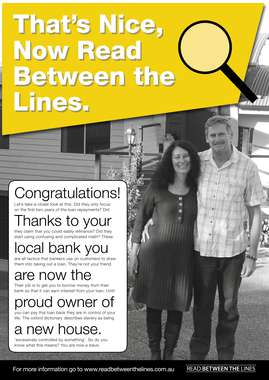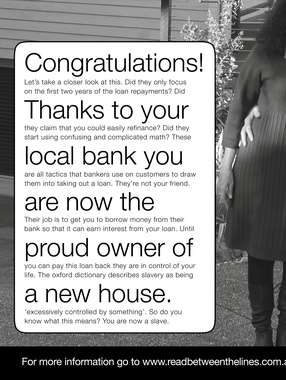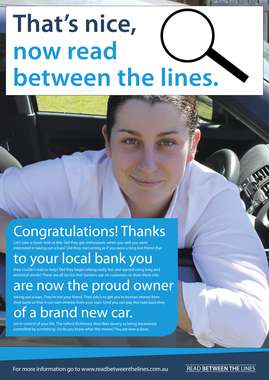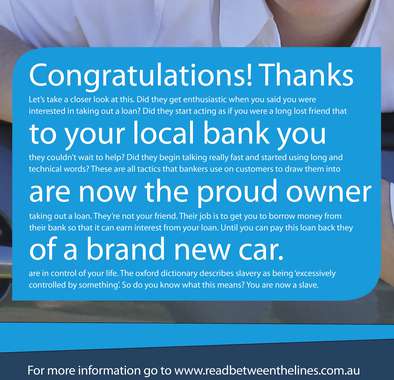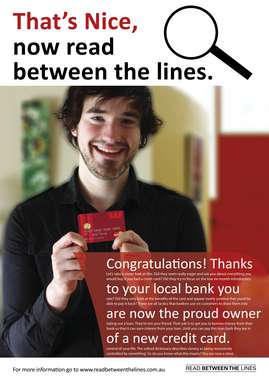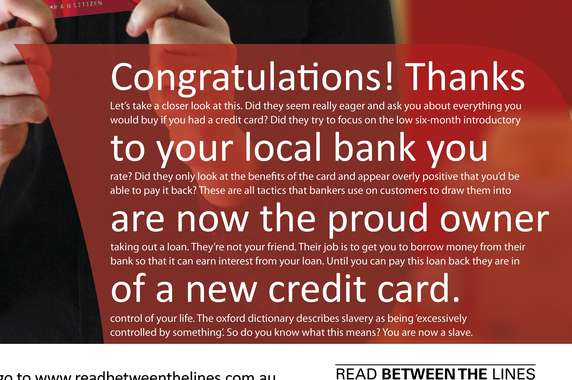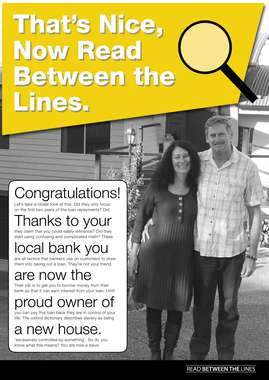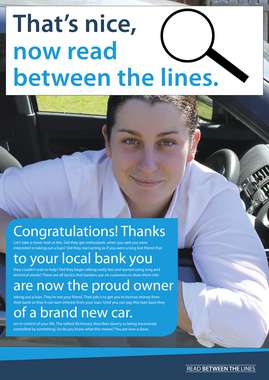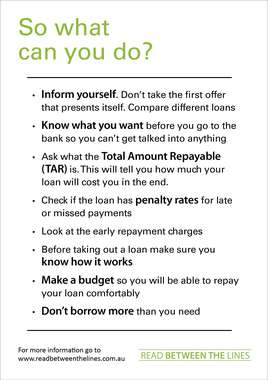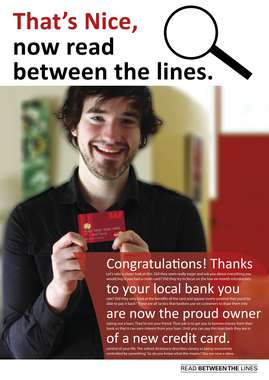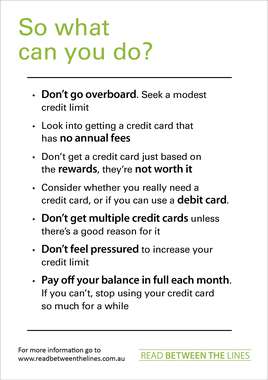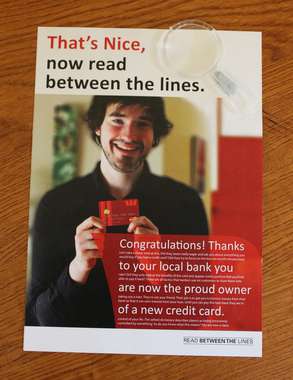Read Between the Lines
by Emma
This work has been commented by 1 curator(s). Read the comments
Title
Read Between the Lines
Headline
Read Between the Lines
Concept author(s)
Emma Bergman
Concept author year(s) of birth
1991
Concept author(s) contribution
Researched, wrote and designed
Concept author(s) Country
Australia
Friendly Competition
Competition category
Visual communication practice
Competition subcategory
static
Competition field
academic
Competition subfield
student
Subfield description
Queensland College of Art
Check out the Debt. 2012 outlines of Memefest Friendly competition.
Description of idea
Describe your idea and concept of your work in relation to the festival outlines:
The concept is based around the idea that when you are in debt to the banks you are a slave to the banks. This was mostly inspired by the text ‘Debt: the first 5000 years’ by David Graeber, and its statements about slavery. The song also had a small influence, as it sings about the bankers leaving and robbing the nation blind.
This concept has been presented through two different mediums (interactive A2 posters and interactive A5 handouts), and on three different subject (home loans, personal loans, and credit cards). The first medium presented is the interactive A2 posters. These have been set up in the style of a bank advertisement, with the colour schemes and font selections specific to that of the three of the four major banks in Australia. So the home loan has been done in the style of the black and white Commonwealth Bank advertisements, the personal loan in the style of the ANZ advertisements, and the credit card in the style of the Westpac advertisements. On each of the posters there is a block of text about what the bank wants you to see. For example, on the home loans poster it states “Congratulations! Thanks to your local bank you are now the proud owner of a new house.” At the top of the poster there are the words “That’s nice, now read between the lines”. Next to this there is a magnifying glass, encouraging and intriguing the reader to pick it up and take a closer look at the text about the bank. Between the lines of this larger text is a block of smaller text about what bankers are actually like, and the fact that when you’re in debt to a bank you’re a slave to it. At the bottom of the page there is a website suggestion and the read between the lines logo so people have somewhere to go for tips, advice, and help once they’ve read about the issue.
The other medium presented is the interactive handouts. The front of the hand out is almost exactly the same as the poster, except with out the website address. Again it has a magnifying glass attached (in a smaller version) to encourage and intrigue the reader to take a closer look. On the back of the handouts there are tips and advice on the specific topic presented on the front of the handout. The style for the back of the hand out is simple and clear so it feels as though the information is simple and easy to understand. At the bottom there is also the website address and the read between the lines logo.
What kind of communication approach do you use?
To best present the idea the concept uses two different mediums to present the topic. These are interactive A2 posters and interactive A5 handouts. Each of these mediums presents all of the different subjects (home loans, personal loans, and credit cards) so that a clear message is portrayed.
What are in your opinion concrete benefits to the society because of your communication?
The concept benefits society because it helps people to understand a serious situation to do with loans that people often overlook. It points out something wrong in our society and makes its audience more aware and knowledgeable about it. The design has a positive impact on society as it’s informing, not advertising. This is important as it’s not just blasting more advertising messages into the public realm. It’s a campaign aimed at making its viewers more aware of an issue. It’s pursuing a more worthy cause.
What did you personally learn from creating your submitted work?
When producing this concept I learnt a lot more about the different types of loans that I didn’t know about before. This included things like how home loans and credit card repayment work, and what to look for if I ever decide that I need one of these. After going down to a bank I was able to see how they’d react if I said I was thinking about getting a credit card. I was also able to see first hand what tactics they’d use to try and ‘entice me’. Some of these tactics I already knew about, such as the over friendliness of the bankers. However there were a few others I picked up on that I hadn’t thought about before.
Why is your work, GOOD communication WORK?
As stated by Dr Oliver Vodeb, there are three things that make up good communication design work. These are quality, social responsibility, and the fact that it’s meaningful. I have already spoken about how my work is socially responsible in one of the previous questions (What are in your opinion concrete benefits to the society because of your communication?), so in this section I will state why my work is of high quality and meaningful.
The design is of high quality firstly because it is based on a high level of research. Therefore, all of the information provided is knowledgeable and accurate. Secondly, the design educates its audience on a subject that will benefit them in the future. It’s not just another advertisement trying to get consumers to buy something. Finally, both the concept and the design are engaging and memorable. I say this because it gets its audience to interact with the posters and handouts using the magnifying glass, which is an idea that isn’t often used. This will mean that it will stick with its audience and provoke them to do something about it.
The design is very meaningful to me, as I have never really thought about debt in this way. Therefore, it has been educating for me. Through my research I have learnt a lot about banks, loans, and the way that they work (as seen in the answer to the question ‘What did you personally learn from creating your submitted work?’). After doing this brief it has made me want to continue pushing this topic and try to make people aware of the situation. I know people who have fallen into this trap, and I like knowing that I have the opportunity to create something so that it won’t happen to others. It has also made me want to do more awareness campaigns outside of university and this brief, on other interesting and meaningful topics.
Where and how do you intent do implement your work?
As there are two different mediums there will be two different ways to implement the work. Firstly I would print them out. As I am a student and quite broke this hasn’t been able to be done yet. However there is a budget in place and I can see it as being achievable. The A2 posters would be hung in places where people have time to look and take in what the posters are saying. This may be somewhere like a bus stop or a train station, or even in larger shopping centers near the seats in the middle of the isles. The A5 handouts would be dropped into people’s letterboxes. As I don’t have the ability or the authority to find out the living situations or personal information of the general public this would be done at random. Even though the people in these houses may not be in the situation described on the handout they’re given, they may know someone who is. As the handout is interesting and interactive they would grab peoples’ attention, and hopefully mean that they pass on the information to those in need of it.
In the future I also intend to set up a website. This would be set up as a place where people could contact me to get more information and advice about what they should do in their personal situations.
Did your intervention had an effect on other Media. If yes, describe the effect? (Has other media reported on it- how? Were you able to change other media with your work- how?)
Since I haven't released it into the public realm yet I haven't been able to see how people would react, so it's not possible to tell what people would do.
Curators Comments

Shoaib Nabi
Reading between the lines or a.k.a the "fine print" is a compelling sell. Your work is comprehensive and successful in my impression as a visual communication piece that retains the formal institutional look. It engages me and yes I do require to enlarge (come closer) to read. You don't need the magnifying glass. It is the pause that one takes and the question you are led to read could make the borrower much more aware about the decision they are about to make. I am not convinced that it will stop someone who is desperate for credit to however change their mind. I am glad to hear that you are planning to develop a website. Think about the target audience and where you can promote a link to your website. Students need a very different approach then a newlyweds thinking of buying their first home or a single parent or someone who need to take a loan for medical needs. You need to think of approaches that speaks directly to the audience since your campaign is widespread. Lots of potential here I would encourage you to take it several steps further and if possible work with a local non-profit organization to help the community.

